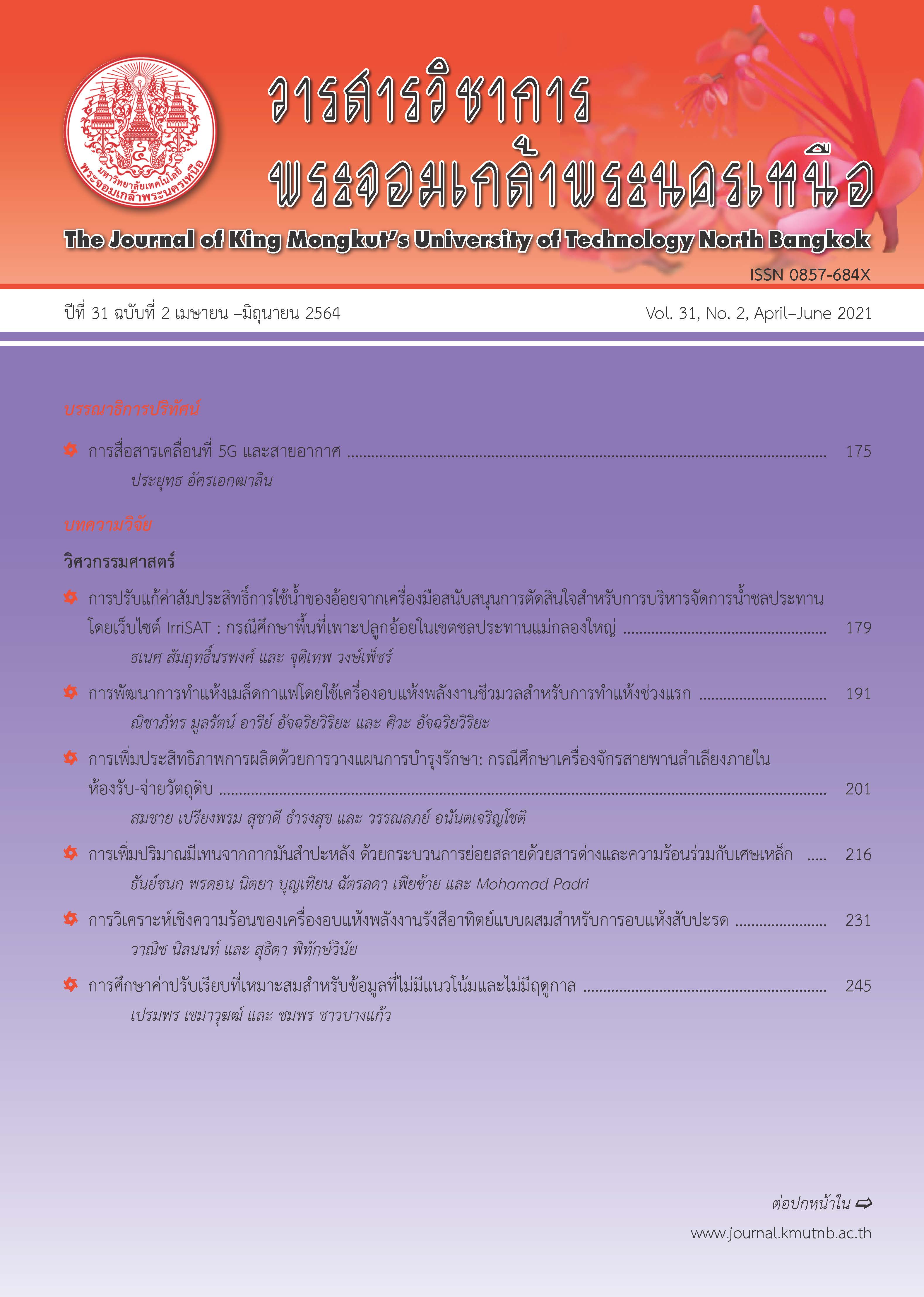ผลกระทบของพารามิเตอร์การเชื่อมเสียดทานแบบกวนต่อความแข็งแรงดึงของรอยต่อชนอะลูมิเนียมผสมหล่อกึ่งของแข็งเกรด 2024
Main Article Content
บทคัดย่อ
การเชื่อมเสียดทานแบบกวนเป็นการเชื่อมแบบไม่หลอมละลายซึ่งให้คุณภาพรอยเชื่อมที่ดี โดยเฉพาะสำหรับวัสดุที่เชื่อมได้ยากด้วยวิธีหลอมละลาย อย่างไรก็ตาม ในการเชื่อมเสียดทานแบบกวนนั้นจำเป็นต้องตั้งพารามิเตอร์การเชื่อมให้เหมาะสมเพื่อให้ได้รอยเชื่อมที่ดี ประกอบกับการศึกษาเรื่องการเชื่อมวัสดุอะลูมิเนียมผสมหล่อกึ่งของแข็งยังมีจำนวนน้อย งานวิจัยนี้จึงมีวัตถุประสงค์เพื่อศึกษาผลกระทบของพารามิเตอร์การเชื่อมเสียดทานแบบกวนตอ่ โครงสร้างจุลภาค และความแข็งแรงดึงของแนวเชื่อมต่อชนวัสดุอะลูมิเนียมผสมหล่อกึ่งของแข็ง 2024 ด้วยเทคนิคออกแบบการทดลองแบบแฟกทอเรียลเต็มจำนวนโดยกำหนดปัจจัยในการทดลอง 3 ปัจจัย ได้แก่ ความเร็วรอบในการหมุนกวนที่ 530 และ 790 รอบต่อนาที ความเร็วเดินเชื่อมที่ 22 และ 36 มิลลิเมตรต่อนาที และรูปทรงของหัวกวน แบบทรงกรวย ทรงกระบอกเรียบ และทรงกระบอกเกลียวผลการทดลองพบว่า ผลกระทบหลักที่ส่งผลต่อค่าความแข็งแรงดึงมากที่สุด คือ ความเร็วรอบในการหมุนกวน และรูปทรงของหัวกวนตามลำดับ ที่ระดับนัยสำคัญ 95% ในขณะที่ความเร็วเดินเชื่อมในช่วงระดับปัจจัยที่ศึกษาไม่ส่งผลต่อความแข็งแรงดึงอย่างมีนัยสำคัญ โดยรูปทรงของหัวกวนแบบทรงกระบอกเรียบ ความเร็วรอบในการหมุนกวน 530 รอบต่อนาที และความเร็วเดินเชื่อม 36 มิลลิเมตรต่อนาที ให้ค่าเฉลี่ยความแข็งแรงดึงสูงสุด 212 เมกะปาสคาล คิดเป็นความแข็งแรงดึงของงานเชื่อมต่อเนื้อวัสดุเดิมเท่ากับ 99%
Article Details
บทความที่ลงตีพิมพ์เป็นข้อคิดเห็นของผู้เขียนเท่านั้น
ผู้เขียนจะต้องเป็นผู้รับผิดชอบต่อผลทางกฎหมายใดๆ ที่อาจเกิดขึ้นจากบทความนั้น
เอกสารอ้างอิง
[2] R. S. Mishra and Z. Y. Ma, “Friction stir welding and processing,” Materials Science and Engineering, vol. 50, no. 1–2, pp. 1–78, 2005.
[3] J. Wananasin, “Semi-solid die casting technology,” in Proceedings of the Third Thai Foundry Conference, Bangkok, Thailand, November 23, 2006, pp. 1–12 (in Thai).
[4] C. Yu, D. Hua, J. Li, J. Zhao, M. Fu, and X. Li, “Effect of welding heat input and post-welded heat treatment on hardness of stir zone for friction stir-welded 2024-T3 aluminum alloy,” Transactions of Nonferrous Metals Society of China, vol. 25, no. 8, pp. 2524–2532, 2015.
[5] W. M. Thomas, E. D. Nicholas, J. C. Needham, M. G. Murch, S. P. Temple, and C. J. Dawes, “Friction Stir Butt Welding,” International Patent Application, no. PCT/GB92/02203 and GB patent application, no. 9125978.8, 1991.
[6] H. J. Liu, H. Fuji, M. Maeda, and K. Nogi, “Tensile properties and fracture locations of friction stir welded joints of 2017-T351 aluminum alloy,” Journal of Materials Processing Technology, vol. 142, no. 3, pp. 692–696, 2003.
[7] M. Imam, V. Racherla, and K. Biswas, “Effect of post weld natural aging on mechanical and microstructural properties of friction stir welded 6063-t4 aluminium alloy,” Journal of Materials and Design, vol. 64, pp. 657–686, 2014.
[8] J. Guo, “Solid state welding processes in manufacturing,” in Handbook of Manufacturing Engineering and Technology, London: Springer- Verlag, 2015, pp. 576–583.
[9] P. Muangjunburee, The effect of Welding Parameters on Metallurgical and Mechanical Properties of Joining of Semi Solid (SSM) Aluminium Alloy A356 by Friction Stir Welding Process (FSW). Songkla: Prince of Songkla University, 2007 (in Thai).
[10] Y. C. Lin, J. J. Liu, and J. N. Chen, “Material flow tracking for various tool geometries during the friction stir spot welding process,” Journal of Materials Engineering and Performance, vol. 22, no. 12, pp. 3674–3683, 2013.
[11] J. Y. Sheikh-Ahmad, F. Ozturk, F. Jarrar, and Z. Evis, “Thermal history and microstructure during friction stir welding of Al–Mg alloy,” The International Journal of Advanced Manufacturing Technology, vol. 86, pp. 1071– 1081, 2016.
[12] A. K. Lakshminarayanan, S. malarvizhi, and V. Balasubramanian. “Developing friction stir welding window for AA2219 aluminium alloy,” Transactions of Nonferrous Metals Society of China, vol. 21, no. 11, pp. 2339–2347, 2011.
[13] J. Jacob, S. P. Shanmunghanatan, and M. B. Kiran, “Effect of tool on microstructure and mechanical properties of friction stir processed AA2024- T351 aluminium alloy,” Materials Today: Proceedings, vol. 5, no. 1, pp. 2965–2979, 2018.
[14] I. Radisavljevic, A. Zivkovic, N. Radovic, and V. Grabulov, “Influence of FSW parameters on formation quality and mechanical properties of Al 2024-T351 butt welded joints,” Transactions of Nonferrous Metals Society of China, vol. 23, no. 12, pp. 3525–3539, 2013.
[15] H. K. Mohanty, M. M. Mahapatra, P. Kumar, P. Biswas, and N. R. Mandal, “Modeling the effects of tool shoulder and probe profile geometries on friction stirred aluminum welds using response surface methodology,” Journal of Marine Science and Application, vol. 11, pp. 493–503, 2012.

